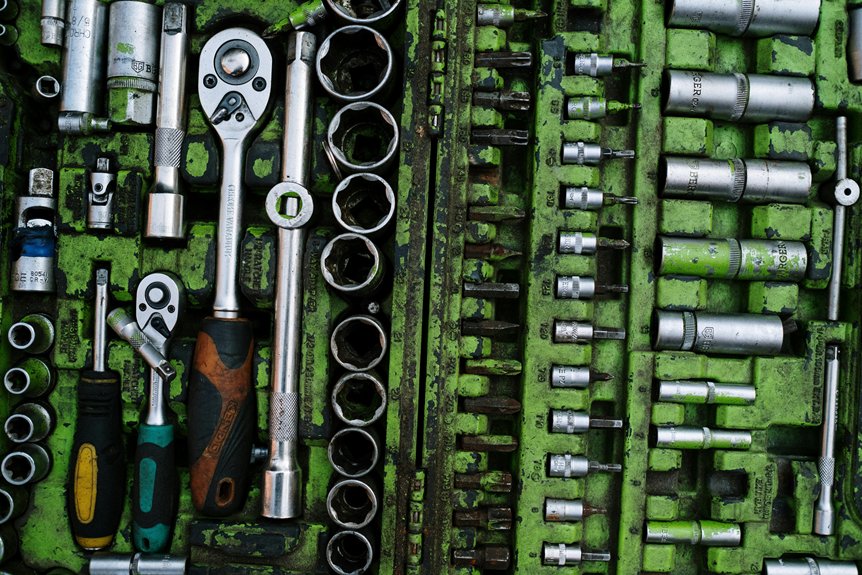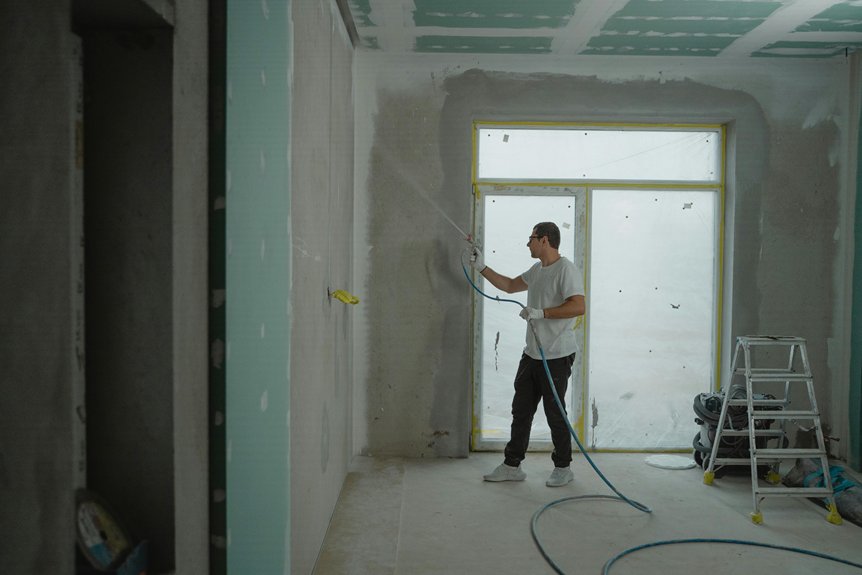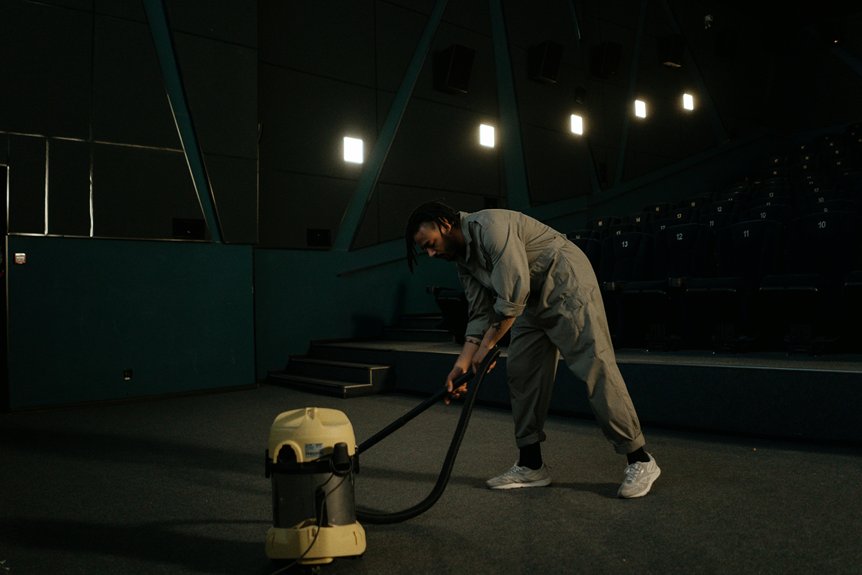Maintaining your whole-home humidifier is essential for ideal air quality and performance. Regular filter checks and replacements, along with proper cleaning of components, can greatly impact efficiency. Monitoring humidity levels guarantees you stay within the perfect range, while seasonal inspections of drain lines prevent clogs. To maximize your humidifier’s effectiveness, consider these seven essential maintenance tips that can help extend its lifespan and improve your indoor environment.
Key Takeaways
- Regularly check and replace filters every three to six months to maintain air quality and humidity levels.
- Clean component parts with mild detergent and warm water, paying special attention to the water reservoir.
- Monitor humidity levels with a hygrometer, ensuring they stay between 30% and 50% for optimal comfort.
- Inspect and clean drain lines at least once a season to prevent clogs and potential mold growth.
- Schedule professional maintenance annually to extend the lifespan and efficiency of your humidifier.
Regularly Check and Replace Filters

While maintaining your whole home humidifier, it’s important to regularly check and replace the filters.
Different filter types, such as HEPA or activated carbon, have varying filter lifespans depending on usage and environmental conditions. Generally, you should inspect filters every month and replace them every three to six months to guarantee peak performance.
A clogged or worn filter can hinder humidity levels and affect air quality. Keeping track of your filter’s lifespan helps you avoid costly repairs and inefficient operation.
Clean the Humidifier Components
To guarantee your whole home humidifier operates efficiently, you need to regularly clean its components.
Start by identifying the component materials—plastic, metal, or rubber—and choose appropriate cleaning techniques for each. For plastic parts, use a mild detergent and warm water, while metal components may require a vinegar solution to eliminate mineral buildup.
Always verify you rinse thoroughly to prevent residue. Pay special attention to the water reservoir and any filters, as they can harbor bacteria.
Monitor Humidity Levels
To maintain ideal comfort and health in your home, it’s essential to monitor humidity levels regularly.
The perfect humidity range is typically between 30% and 50%, so using a hygrometer can help you track these levels accurately.
Keep in mind that seasonal adjustments may be necessary to maintain this range throughout the year.
Ideal Humidity Range
Maintaining the ideal humidity range in your home is essential for comfort and health, as it can prevent issues like dry skin and respiratory problems. The ideal indoor humidity level typically falls between 30% and 50%. Below, you’ll find a table to highlight the effects of varying humidity levels:
| Humidity Level | Effects on Health |
|---|---|
| Below 30% | Dry skin, respiratory issues |
| 30% – 50% | Preferred comfort and health |
| Above 50% | Mold growth, dust mites |
| Above 60% | Increased allergy symptoms |
Keep an eye on these levels to mitigate negative humidity effects.
Use a Hygrometer
Monitoring humidity levels accurately is key to achieving the ideal indoor environment. To do this, use a hygrometer, which provides essential humidity measurement.
There are several hygrometer types, including analog and digital models, each with unique advantages. Digital hygrometers typically offer quicker readings and higher accuracy, while analog models are often more durable.
Place your hygrometer in a central location in your home for the most reliable readings. Regularly check the measurements to guarantee your humidifier maintains ideal humidity levels, preventing issues like mold growth or dry skin.
Consistent monitoring is vital for effective humidifier maintenance and overall comfort.
Seasonal Adjustments Needed
As seasons change, it’s essential to adjust your humidifier settings to maintain ideal indoor humidity levels.
In winter, when the air is drier, you’ll need to increase your humidity control to about 30-40%. Conversely, during the summer months, lower humidity levels around 40-50% are often more comfortable.
Use a hygrometer to monitor these levels regularly, ensuring your seasonal settings align with outdoor conditions. Neglecting these adjustments can lead to discomfort or damage to your home.
Stay proactive and keep your humidifier well-maintained to support peak humidity control throughout the year.
Inspect and Clean Drain Lines
Inspecting and cleaning the drain lines of your whole home humidifier is essential for ensuring clear drainage and preventing water damage.
You should aim to clean these lines at least once a season to maintain ideal performance.
Using the right tools will make this task more efficient and effective.
Importance of Clear Drainage
While maintaining your whole home humidifier, ensuring clear drainage is vital for ideal performance. Clogged drain lines can lead to drainage issues that cause moisture buildup, creating an environment conducive to mold growth and other complications.
Regularly inspect the drain lines for any blockages or debris. If you notice slow drainage or water pooling, it’s important to act swiftly.
Cleaning the drain lines not only prevents these problems but also enhances the efficiency of your humidifier, ensuring it operates effectively and maintains the desired humidity levels.
Prioritizing clear drainage safeguards both your system and indoor air quality.
Recommended Cleaning Frequency
To guarantee ideal performance and prevent issues, you should inspect and clean the drain lines of your whole home humidifier at least once every three months.
Sticking to this cleaning schedule helps avoid clogs and guarantees proper drainage. During your maintenance checks, look for any signs of mold or mineral buildup, which can compromise efficiency.
Additionally, verify that the drain lines are securely connected and not pinched or kinked. Following these maintenance tips will enhance your humidifier’s lifespan and improve indoor air quality.
Consistent attention to drain lines is essential for peak operation.
Tools for Effective Cleaning
When it comes to effectively cleaning the drain lines of your whole home humidifier, having the right tools on hand can make all the difference.
First, gather essential cleaning supplies, such as a soft brush, a microfiber cloth, and a suitable cleaning solution. You’ll also need a wet/dry vacuum to remove any stubborn debris.
Follow your maintenance checklist to guarantee you inspect the drain lines regularly, removing any clogs or buildup. This proactive approach prevents water damage and maintains peak performance.
Use Distilled Water
Using distilled water in your whole home humidifier is essential for peak performance and longevity.
The benefits of distilled water include:
- Reduced mineral buildup: Less scaling and deposits in the unit.
- Improved air quality: Fewer contaminants are released into your home.
- Extended equipment life: Minimizes wear on internal components.
- Lower maintenance needs: Requires less frequent cleaning.
While distilled water is the best option, alternatives like reverse osmosis water can be used, but they may not provide the same level of effectiveness.
Always prioritize distilled water to guarantee superior humidifier function.
Schedule Professional Maintenance
In addition to using distilled water, scheduling professional maintenance for your whole home humidifier is crucial for ideal operation. Regular service guarantees your system runs efficiently and prolongs its lifespan. A professional will follow a maintenance checklist that typically includes:
| Maintenance Task | Frequency |
|---|---|
| Check Water Supply | Annually |
| Clean Humidifier Tank | Biannually |
| Inspect Components | Annually |
| Replace Filters | Every Season |
| Test Humidistat | Annually |
Keep an Eye on the Humidistat

How often do you check your humidistat? Regular monitoring is essential for ideal humidifier performance.
Humidity fluctuations can lead to discomfort and damage. Here’s what you should do:
- Calibrate your humidistat at least once a year to guarantee accuracy.
- Monitor humidity levels regularly to prevent excessive dryness or moisture.
- Adjust settings based on seasonal changes for consistent comfort.
- Inspect for issues like wiring problems or sensor malfunctions that could affect readings.
Conclusion
By following these essential maintenance tips, you can guarantee your whole home humidifier operates efficiently and effectively. Regularly check and replace filters, clean components, monitor humidity levels, and inspect drain lines to prevent issues. Using distilled water can further enhance performance, while scheduling professional maintenance keeps your system in peak condition. Finally, don’t forget to keep an eye on the humidistat to maintain ideal humidity levels. Proper care leads to improved air quality and a healthier living environment.




